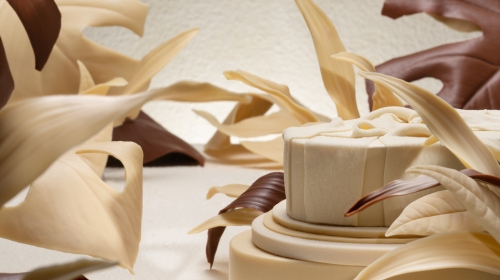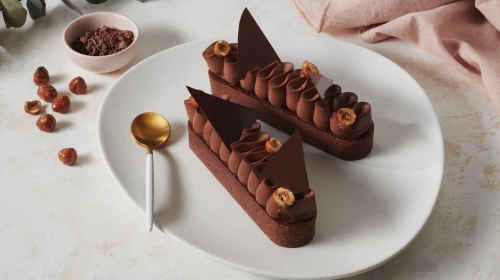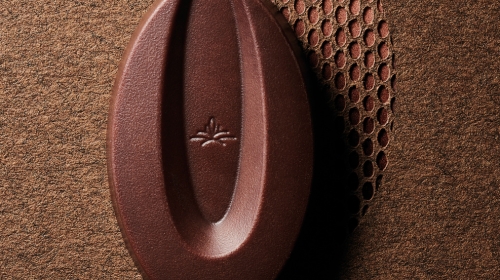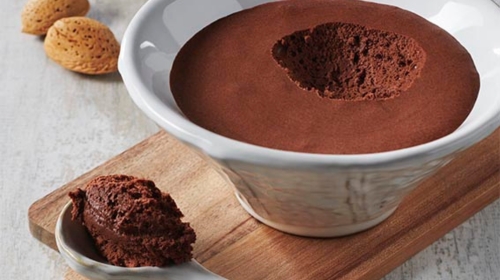Plant-based pastries: what to replace butter, milk and eggs with
How can we swap butter, milk, cream or eggs in our recipes? If you've ever tried to make a vegan recipe, you've probably asked yourself this question. Or perhaps you know people with special diets? Whatever your circumstances, the trend for plant-based pastry-making is getting bigger and bigger. To get an in-depth perspective on the subject, we asked Nils, better known as @basilic_et_citron_vert. In this article, he helps us get to grips with the basic ideas behind a new approach to pastry-making. He also shares a few tips for successful vegan creations.
What is plant-based pastry-making?
Let's start with a definition so we know exactly what this article is about. If pastry-making is "plant-based", that means it uses no ingredients of animal origin. You’d be right in thinking that many of pastry-making’s basic ingredients come from animals, including milk, cream, butter, eggs, gelatin, and honey.
We can also call this vegan pastry-making, although the word "vegan" actually refers to a whole lifestyle and way of being a consumer.

Why is it worth trying plant-based pastry-making?
The many reasons to go plant-based
There are all kinds of reasons to adopt this new way of thinking about recipes:
- To adapt to specific diets or food allergies and intolerances (for example, lactose-free diets). This is important whether you need to do it for yourself, a friend or family member, or a guest.
- Concern for animal rights and welfare (this is one of the main reasons cited by vegans).
- For the ecological reason of reducing our environmental impact: Livestock farming is a major source of greenhouse gases, which accelerate climate change.
- To try out new things and explore new ingredients and flavors: Eggs, milk, butter and cream sometimes mask the flavor of other ingredients such as chocolate, vanilla and fruit. By replacing them, you can bring out other flavors in all their different nuances.
Plant-based pastries aren’t widely available in France yet, but they are becoming increasingly popular. The challenge is to make pastries that are just as indulgent and delicious as they would be otherwise!
So what we want to know is how we can make indulgent pastries and desserts that don’t use animal-based ingredients. The first step is to find plant-based alternatives.
How to replace animal-based ingredients in vegan recipes
Replacing eggs
Egg plays several roles in pastry-making, as it emulsifies, binds ingredients together, and adds texture. If we’re going to replace eggs, we need to understand why they are being used in the first place.
- If you are looking for a binding ingredient, egg can be replaced with apple compote or banana purée in cakes, for example.
- Aquafaba is a well-known alternative to egg white. It’s nothing more complicated than the cooking water from legumes. Chickpea water works best.
- Guar gum can also be used for moist sponges. This ingredient stabilizes emulsions and can act as a thickener. That said, guar gum is less easy to find than the first two options.
Eggs are undoubtedly the most complicated ingredient to replace because they play so many different roles.

Replacing butter
Margarine, ghee, and cocoa butter
Butter is important to both the taste and texture of your recipes. The best-known plant-based alternative is margarine (which is an emulsion of water and oil). This is the most obvious and easiest way to replace butter.
Another option is cocoa butter!
Can clarified butter be used for plant-based pastries? Clarified butter, also known as ghee, is butter that has been heated and partially skimmed. This removes its proteins, including lactose. It’s suitable for people with lactose intolerance, but it isn’t a plant-based alternative. It's a processed butter, but it's still butter.
Vegetable oils (on their own or mixed with water)
Nils finds that margarine brings a taste of its own to recipes, so he makes his own mixture: water + vegetable oil! Usually he uses coconut oil (in a combination of 80% oil and 20% water - so for example, if you want to replace 250g of butter, you need 200g of oil and 50g of water). Another alternative is making a mixture of water and grapeseed oil. This has the advantage of being flavorless.
Olive oil can also be used to replace butter, if you want a cake to include its particular taste, for example.
One thing to be aware of is differences in melting points. Butter and the various oils are not all used at the same temperature. Butter’s melting point is around 85°F (30°C). For coconut oil, it’s 75°F (25°C), and for cocoa butter 97°F (36°C). If you go over melting point too much, you risk burning your oil or fat!
Oilseed purées
You can also use peanut butter, almond purée, or pistachio purée. These options bring a different flavor that can be both interesting and delicious.
Replacing cow's milk
Cow's milk is also very easy to substitute, given all the options on the market. You can use a plant-based drink of your choice. Nils uses oat and rice drinks when he doesn't want to add flavor to a recipe. He also likes the more pronounced flavors of coconut and almond. Depending on your taste, you might consider hazelnut or soy too. Working out quantities couldn’t be easier, as you use the same amount as you would with cow's milk.
In some recipes, milk can also be replaced with water (such as in crêpe batter).
Replacing cream
As with milk, there are plenty of plant-based alternatives to cream. Nils mainly uses coconut or soy cream. Coconut cream is naturally a little oilier and thicker, so it works well as an alternative.
There are also plant-based creams you can beat to make whipped cream. They contain emulsifiers which make sure they expand nicely.
Replacing gelatin
Did you know that gelatin is always animal-based, whether it’s beef, pork, or fish? You'll need to look to agar-agar or pectins for plant-based alternatives. If you’d like to know more about how to choose a gelling agent, read our article. Your choice depends on your recipe and the result you want to achieve.
Replacing honey
If you need to replace honey, consider sugar, agave syrup, or maple syrup (although this is more liquid than honey).
What about chocolate?
Don't forget that milk, white, and blond chocolates all contain milk! If you can't use plant-based couvertures like Amatika (a Valrhona product for professionals), you can opt for dark chocolate. Valrhona's dark couverture chocolates aren’t vegan-certified, but they may be suitable for recipes that don’t use animal-based ingredients. And don't forget the Inspiration range!

How do you make basic recipes plant-based?

- Chocolate mousse: Instead of egg whites, use chickpea water. Go for dark or vegan chocolate. An easy-to-make and delicious dessert!
- Ganache and crémeux: These recipes work very well with plant-based drinks. There are even examples in the Reasonable Indulgence book, where certain crémeux are made with water and a potato starch base.
- Whipped cream: Try coconut milk or special vegan whipping alternatives.
- Confits: Go for pectin.
- Banana bread: Use an almond drink and banana purée instead of milk, butter, and eggs.
- Sponges and doughs: Use a mixture of water and oil. Here's a recipe that Nils uses regularly.
Vegan sponge recipe:
- 450g flour
- 180g confectioners’ sugar
- 50g almond flour
- 4g salt
- 180g coconut oil
- 160g water
Mix the flour with the liquid coconut oil until they form fine crumbs. Add the confectioners’ sugar, almond flour, water and salt. Mix them all together. Leave the mixture in the refrigerator for approx. 30 minutes before rolling out the dough between 2 sheets of parchment paper. Put it back in the refrigerator before cutting it into shape if necessary. Bake in a preheated oven at 320°F (160°C) for approx. 25 minutes.
Nils' tips for successful plant-based pastries
First of all, Nils recommends being extra-careful when making your first vegan recipes. Not all products can be used in the same way, as we mentioned for shortbread crust, for example. Fats also have different melting points. It’s important to keep within them so as not to burn your oils.
Put chickpea water in the refrigerator the day before to make sure it expands.
Pay close attention to gelling agents’ quantities and directions for use. However, this is just as much the case when you’re making traditional pastries.
Once you've experimented a little and got to grips with pastry-making’s basic principles, your plant-based creations will work a treat!
We hope this article gives you a good introductory guide to making plant-based preparations. Order your ingredients from our online store and get baking!
 Microsoft Edge
Microsoft Edge
 Google Chrome
Google Chrome
 Mozilla Firefox
Mozilla Firefox
 Opéra
Opéra


